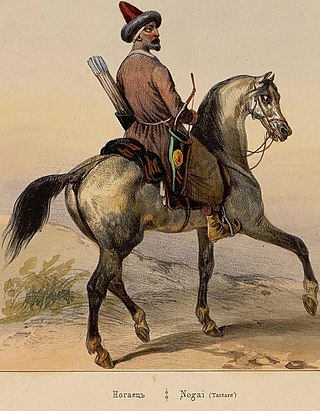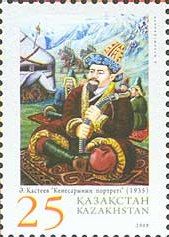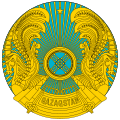Related Research Articles

Kazakhstan, the largest country fully within the Eurasian Steppe, has been a historical crossroads and home to numerous different peoples, states and empires throughout history. Throughout history, peoples on the territory of modern Kazakhstan had nomadic lifestyle, which developed and influenced Kazakh culture.

The Kalmyks are a Mongolic ethnic group living mainly in Russia, whose ancestors migrated from Dzungaria. They created the Kalmyk Khanate from 1635 to 1779 in the south of the European part of Russia territory. Today they form a majority in Kalmykia, located in the Kalmyk Steppe, on the western shore of the Caspian Sea.

The Dzungar Khanate, also written as the Zunghar Khanate, was an Inner Asian khanate of Oirat Mongol origin. At its greatest extent, it covered an area from southern Siberia in the north to present-day Kyrgyzstan in the south, and from the Great Wall of China in the east to present-day Kazakhstan in the west. The core of the Dzungar Khanate is today part of northern Xinjiang, also called Dzungaria.

Oirats or Oirds, also formerly Eluts and Eleuths, are the westernmost group of the Mongols whose ancestral home is in the Altai region of Siberia, Xinjiang and western Mongolia.

The Uzbek Khanate, also known as the Abulkhair Khanate was a Shaybanid state preceding the Khanate of Bukhara. During the few years it existed, the Uzbek Khanate was the preeminent state in Central Asia, ruling over most of modern-day Uzbekistan, much of Kazakhstan and Turkmenistan, and parts of southern Russia. This is the first state of the Abulkhairids, a branch of the Shaybanids.

There has been a substantial population of Russians in Kazakhstan since the 19th century. Although their numbers have been reduced since the breakup of the Soviet Union, they remain prominent in Kazakh society today. Russians formed a plurality of the Kazakh SSR's population for several decades.

The Kazakh Khanate, in eastern sources known as Ulus of the Kazakhs, Ulus of Jochi, Yurt of Urus, was a Kazakh state in Central Asia, successor of the Golden Horde existing from the 15th to the 19th century, centered on the eastern parts of the Desht-i Qipchaq.

Wāli-ūllah Abū'l-Mansūr Khan, better known as Abylai Khan or Ablai Khan was Khan of the Middle Jüz was the last independent Kazakh Khan of the Kazakh Khanate before the Khanate was absorbed into the Russian Empire.

A jüz is one of the three main territorial and tribal divisions in the Kypchak Plain area that covers much of the contemporary Kazakhstan. It represents the main tribal division within the ethnic group of the Kazakhs.

The Bukey Horde, also known as the Inner Horde or Interior Horde, was an autonomous khanate of Kazakhs located north of the Caspian Sea in between the Ural and Volga Rivers, but never reaching these rivers. The khanate officially existed from 1801 to 1845, when the position of khan was abolished and the area was fully absorbed into the administration of the Russian Empire. It was located in the western part of modern-day Kazakhstan. Its lands were spread over about 71,000 square kilometers.
Abū'l-Fath Tauke Mūhammad bin Salqām-Jahangīr Khan ruled as a Kazakh khan of the Kazakh Khanate. In 1652 after the death of his father Jahangir Khan, the ruler of Jungars Erdeni Batyr had dramatically increased his military pressure on the Kazakh Khanate in an attempt to conquer it. Eventually he died in 1670. Kaldan Boshakty replaced him, who was later succeeded by Seban Rabtan (1699–1729). All through these invasions, a weak Kazakh ruler named Bahadur Khan had taken the throne. He was quickly deposed by the Kazakhs, allowing Tauke Muhammad to take the Kazakh throne.

The Nogais are a Turkic ethnic group who live in the North Caucasus region. Most are found in Northern Dagestan and Stavropol Krai, as well as in Karachay-Cherkessia and Astrakhan Oblast; some also live in Chechnya, Dobruja, Turkey, Kazakhstan, Uzbekistan, Ukraine and a small Nogai diaspora is found in Jordan. They speak the Nogai language and are descendants of various Mongolic and Turkic tribes who formed the Nogai Horde. There are seven main groups of Nogais: the Ak Nogai, the Karagash, the Kuban-Nogai, the Kundraw-Nogai, the Qara-Nogai, the Utars and the Yurt-Nogai.

The Kalmyk Khanate was an Oirat khanate on the Eurasian steppe. It extended over modern Kalmykia and surrounding areas in the North Caucasus, including Stavropol and Astrakhan. During their independence, the Kalmyks both raided and allied with Russia in turn, engaging in numerous military expeditions against the Crimean Tatars, the Ottoman Empire, neighboring Muslim tribes, and the highlanders of the North Caucasus. The Khanate was annexed by the Russian Empire in 1771.

The Kazakh–Dzungar Wars (1643–1756) were a series of long conflicts between the Kazakh Juzes and Dzungar Khanate. The strategic goal for the Dzungars was to increase their territories by taking neighboring lands that were part of the Kazakh Khanate. The Dzungars were not only seen as a threat by the Kazakhs, but for the rest of Central Asia and the Russian Empire itself.
The Kazakh War of Independence (1468–1500) was a conflict fought in Central Asia between the Kazakh Khanate and the Uzbek Khanate, which attempted to maintain its control over most of modern-day Kazakhstan, which at the time was under Uzbek rule. The war started after Abu'l-Khayr, Khan of the Uzbek Khanate, attacked Zhetysu in 1468 which was controlled by a small band of rebel Kazakhs who had split from the original Uzbek Khanate. Abu’l Khayr did so in an attempt to prevent the growing Kazakh influence among the steppe. However, he died unknowingly, making it easier for the Kazakhs to expand their influence. After Abu'l-Khayr Khan's death, the Uzbeks continued to be ruled by the Shaybanids who fought against the Kazakhs in the cities that were on the Syr Darya until both sides agreed to peace in 1500 with the Kazakh Khanate gaining its sovereignty from the Uzbek control. At the end of the war, the Uzbek Khanate transferred most of Kazakhstan to the Kazakh Khanate.
Kazakh rebellions are events and actions in the history of Kazakhstan in which the Kazakh people engaged in civil disobedience or armed resistance to state power. The national uprisings of the Kazakhs in the 18th–19th centuries are commonly referred to as national liberation uprisings.
Kazakh diaspora is a term used to collectively to describe the ethnic or people of Kazakh descent who reside in outside of Kazakhstan across the world in various countries as a result of annexed territories and diasporic migration in the late 19th and early 20th centuries. It is estimated that more than four million Kazakhs live abroad. Although the Kazakh diaspora is usually a sparse one, particularly in Western Europe and United States, it retains ethnic enclaves within the countries of Turkey, Iran, and Afghanistan.

Kenesary Qasymov, or Kenesary Kasymuly, Kenesary Khan was the last khan of the Kazakh Khanate, grandson of Ablai Khan, from the clan of Genghisid-Tore.
References
- ↑ Olcott, Martha (1995). "The Russian Conquest". The Kazakhs. Hoover Institution Press. pp. 39–40.
- ↑ Olcott, Martha (1995). "The Russian Conquest". The Kazakhs. Hoover Institution Press. p. 45.
- ↑ Olcott, Martha (1995). "The Russian Conquest". The Kazakhs. Hoover Institution Press. p. 44.
- ↑ Olcott, Martha (1995). "The Russian Conquest". The Kazakhs. Hoover Institution Press. p. 53.
- ↑ Ablet Kamalov: Links across time: Taranchis during the uprising of 1916 in Semirech’e and the “Atu” massacre of 1918, in: Alexander Morrison/Cloé Drieu/Aminat Chokobaeva (eds.): The Central Asian Revolt of 1916: A Collapsing Empire in the Age of War and Revolution, Manchester: Manchester University Press, 2019, p. 239.
- ↑ Martha Brill Olcott: The Kazakhs, Stanford (CA): Hoover Press, 1995, p. 75.
